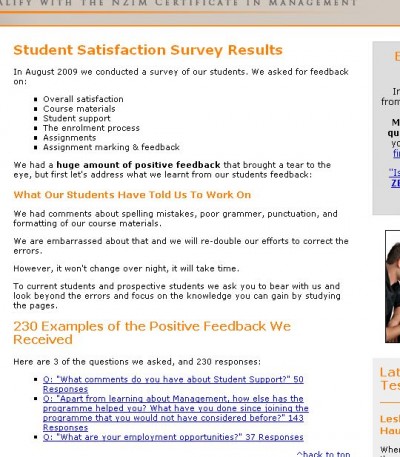I’m about to show you that with your next customer survey, it is possible to generate satisfaction rather than just measure satisfaction.
Let’s consider the customer’s perspective first.
Do any of the following 3 scenario’s sound familiar?
1. Imagine you have just started dinner and the phone rings…
You pick up and it’s someone asking you to partake in a market research survey.
Do you leap at the chance?
2. Imagine you are out and about and get asked to fill in a satisfaction survey…
You get half way through, does it suddenly occur to you how pointless the questions are?
Maybe it occurs to you “surely they will get so little usable information back they really shouldn’t have bothered!”
3. Imagine you get emailed a link to a survey with a free prize at the end…
So you start it, expecting it to take 2 or 3 minutes, but it turns into a 25 minute marathon, so you rush blindly through the rest of the answers just to qualify for the prize.
And then you get to the end and you realise it’s not a free prize, it’s the chance to win a free prize, so you get angry because you’ve wasted your time for no reward.
And just as bad, you’ve provided them with a useless response anyway because you didn’t even read most of the questions.
Sound familiar? (I’m looking at you Subway).
There are 2 major problems with Customer Survey’s these days:
- The customers experience is horrible. Most survey’s are boring and feel pointless
- The whole point of them is to provide actionable information to aid business decisions, right? Well, they they fail dismally at that
Well, I have good news for you, there is a better way.
There is a way to generate satisfaction with a survey rather than just measuring satisfaction.
- Do you want to know more about what turns on your customers?
- Do you want to explore opportunities to grow your customer base, or sell more to your existing customers?
- Do you want to identify defects in your service that you can fix immediately?
- Do you want to be customer-led and pro-active rather than fall behind your competitors?
- Do you want to take action from the results rather than just file them on a shelf somewhere to get dusty?
- Do you want to craft questions that won’t bore your clients to tears?
- Do you want to ask only the most important questions because you know people will get bored if there are more than 10?
- Do you want to motivate your customers to provide you with full answers rather than tick-the-box responses?
- Do you want to communicate to your customers that you really care about their responses?
If you answered “Yes” to these questions, then this is for you.
This Customer Survey Package Is Not For You If…
If you already have a good feeling for what your results will be and just want the data to back up your hunch, walk away now.
I have zero tolerance for that crap.
I’ll strip back your questions to the bare basics and give your customers every chance to answer in the way they want to rather than how you or your boss wants them to answer.
This way you’ll actually get results you can take action on, rather than ones that can immediately start to accumulate dust on a shelf somewhere.
Do you need to pretty much copy the questions from previous years so you can show statistical improvement?
Too bad. I don’t care about the past. I just care about how your customers today can help you adapt to the customers in your future.
So leave your past behind and let’s tap into your customers minds and future-proof your business today.
Q: “How Much Does it Cost?”
- $1800.00
- No hosting fees
Q: “What’s involved?”
We will start with a short meeting. I will ask you questions such as:
- What do you want to achieve?
- What action will you take if the results show x, or y?
- What questions do you think we should ask?
- How will you invite customers to fill it in? (eg by email invitation, hyperlink on your website, or advertising)
- What incentive will you provide for them to fill it in? What’s in it for them? (“Out of the goodness of their heart” will only get you so far)
Geeky Technical Stuff
- I use open source software. My favourite is Lime Survey (check out the demo) or Google Forms or Survey Monkey
- If your website is on an Apache server running php and MySQL, I can host the survey on one of your sub-domains eg http://survey.yourwebsite.co.nz
- Otherwise, I will host the survey on one of my subdomains eg http://yoursurvey.marketingfirst.co.nz, or we could purchase a new domain for your survey if you are really serious


